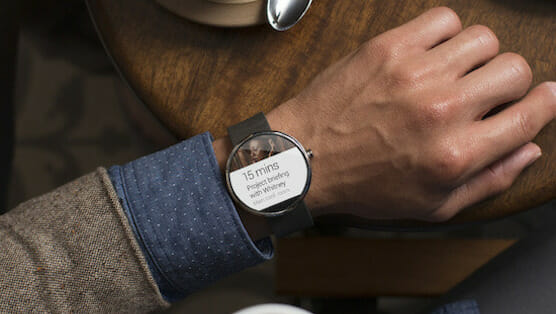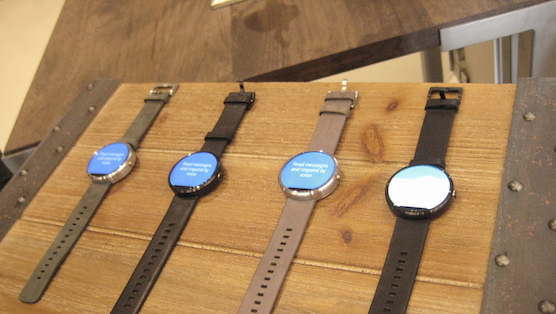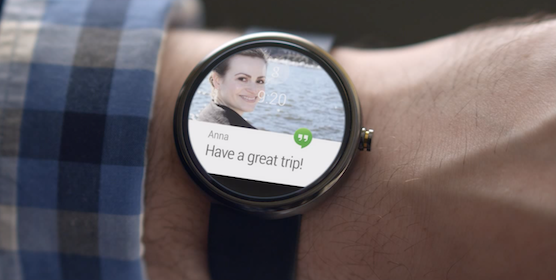
Even when you first get the circular product box in your hands to open it, Motorola is convincing of one and only one thing: the Moto 360 is no normal smartwatch. Although there are other round smartwatches out there, since its unveiling at Google I/O earlier this year, the Moto 360 was really the first device to get tech enthusiasts truly excited for the very near future of smartwatches.
But is this watch’s round design enough to convince the masses that they need another smart device on them at all times?
Hardware

I want to be very clear about something right up front with the Moto 360: this is, by a long shot, the best designed smartwatch on the market. The display is the perfect size, the metal exterior is classy, and the leather bands are fantastic. There is no awkward mini-USB charging port, no big home button, and not a single blemish in how it’s been constructed. The small button on the device’s side is an effortlessly nice addition and the more I use it, the more dislike the idea of using it as any more than a wake/sleep button (so yes, Apple, you have some convincing to do). Motorola went above and beyond to make the Moto 360 look and feel like everything anyone has ever wanted from a smartwatch.
Every other smartwatch—whether it’s the Apple Watch, the Pebble, or the Galaxy Gear—look fairly bulky and clumsy in comparison. I can’t overemphasize how significantly the Moto 360’s circular design sets it apart from the competition. The 360’s 1.56-inch display isn’t exactly high-resolution and you don’t have to look very closely to see the pixels—but that doesn’t mean it doesn’t impress, especially when you see it for the first time.
The device does have one notable flaw though. At the bottom of the round display is a small strip of black cut out from the circle. It’s an odd little thing that obscures part of the screen—and you can even see it when the display is off. Apparently, the engineering of the circular display couldn’t have been pulled off without hiding some of the technology in part of the screen. It’s not a huge deal, but it seems like a case where the ambition of the design was a bit further along than the technology. Either way, I wouldn’t be surprised to see the follow up to the Moto 360 to have found a way around cutting off part of the display.
Software

The Moto 360 runs Android Wear, the new wearable operating system from Google that was launched just this year in its first round of smartwatches. Unlike Android for smartphones, Google has kept Android Wear fairly closed off to OEMs so far. You won’t find any wacky skins or extraneous features in any of the first round of Android Wear devices—and that’s probably a good thing. It’s the opposite of how Google has done things in the past, and in the long run that will probably pay off as they experiment and iterate on feedback from customers. However, as of now, it still feels like beta software in a lot of ways.
I say that primarily because the general functionality of Android Wear feels fairly limited. I like the idea of Android Wear functioning like a glorified Google Now, especially in how simple the actions and gestures are. Swiping down the list is gets you to other apps and notifications while swiping right on a card will give you more info or allow you to act on it in some way. However, because everything is completely full screen at all times, I found that it was easy to get lost in the navigation and not have an easy way of getting back to the thing I wanted to see next.
The main things you’ll find yourself doing with your Moto 360 are check your notifications, check the weather, do Google navigation, see what’s next on your calendar, and maybe do some health tracking. It does all of those things fairly well—or at least as well as Google Now on your phone does. For some people, that’s going to be plenty—and any of the Android Wear smartwatches are going to be the best devices for doing such things.
For me though, I found that I used the Moto 360 mostly just… to tell time. In all seriousness, as someone who didn’t previously wear a watch, it’s really great not having to constantly pull out your phone to check the time or swipe away some notification. But after a week or two with the Moto 360, I didn’t find myself convinced of the platform’s use case. Furthermore, what’s worse than the limited functionality of Android Wear is that the software itself is still fairly laggy. The animations stutter and hiccup pretty frequently and I found that the device was constantly waking itself up when I’d be doing daily activities such as walking and driving.
This brings me to my final complaint about the Moto 360: battery life. Because the device is constantly waking itself up, the battery life really does suffer needlessly. Interestingly, because I found myself not all that interested in what the smartwatch was doing throughout my normal busy day, I was getting through a full day pretty easily with battery to spare. On days of what I would call fairly average use, a full day was a bit harder to come by. Interestingly, I didn’t find the battery life to be a dealbreaker. In fact in many ways, the battery life on the Moto 360 comes close to matching what you can actually do with the device—not a whole lot.
The iPhone wasn’t a cell phone with some extra features, it was three devices in one, as Steve Jobs famously introduced it. By making Android Wear so strongly tied into the Android ecosystem and the things it does, Google has made its operating system nearly invisible. It’s there doing its thing and that’s great, but in this case, “just works” just doesn’t feel like enough.
Verdict
The Moto 360 is the most beautiful smartwatch ever made and that may remain the case for quite some time. As a first generation product, it almost feels like something of a miracle. The strange thing is that the problem with the 360 isn’t a problem with the device itself, but more with the platform as a whole. Smartwatches still have a ton of convincing to do. They aren’t yet the next tablet and they certainly aren’t the next smartphone. When Apple fully unveils its Apple Watch next spring, the industry will be watching and will certainly respond accordingly—like it always does. It’s at that point that we’ll either come running back to the simplicity of Android Wear or see Google dramatically catch its operating system up to speed.
Here’s the bottom line: Motorola knows exactly what it want to do with its smartwatches. It wants to make beautiful, fashionable, wearable devices. Somehow it has managed to pull that off really elegantly on its first try with the Moto 360. Google, on the other hand, still feels unsure of what it wants smartwatches to actually do. The inevitable Android Wear 2.0 might be what takes the Moto 360 a must have device, but as of now, its identity remains clouded by an operating system that is still better at keeping time than anything else.